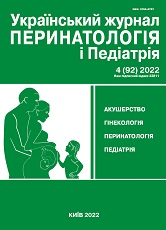The effect of the reparative action drug in treatment of pediatric duodenal ulcer
DOI:
https://doi.org/10.15574/PP.2022.92.33Keywords:
children, duodenal ulcer, H.рylori, drug of reparative functionAbstract
Background. Digestive tract diseases occupy one of the first places in the structure of childhood pathology, including duodenal ulcers (DU), the development of which in 70-100% of cases is associated with H.pylori infection. It is found that the important role in the development of inflammatory process in digestive tract have toll-like receptors 4 (TLR4), due to reactiveness to H.pylori. It is proved that growth factors, in particular epidermal growth factor (EGF), are able to influence on the healing processes in the mucous membrane. It is advisable to include drugs of reparative action in complex treatment of pediatric DU.
Purpose - to evaluate the effect of the reparative action drug in the treatment of pediatric DU, taking into account the dynamics of TLR4 and EGF in blood serum.
Materials and methods. The total clinical group consisted of 39 children aged 7-18 years with H.pylori-associated duodenal ulcer. In 20 patients of the group 1 with DU a standard triple regimen was used. In 19 patients of the group 2 a drug of reparative action was included. The content of TLR4 and EGF in serum were determined by ELISA.Results. It was found that the level of TLR 4 decreased by 15.1% and 27.5% after a course of treatment in patients of the group 1 and in the group 2, respectively сompared to a level before treatment. It is showed that in patients of the group 1 and the group 2 after 3 weeks from the start of treatment there were changes in the content of EGF manifested by a decrease by 19.81% and 23.3%, сompared to a level before treatment.Сonclusions. Our results indicated that after the course of treatment the content of TLR4 and EGF in the group 1 of patients was lower by 12.37% and 3.49% respectively, than in the group 2.
The research was carried out in accordance with the principles of the Helsinki Declaration. The study protocol was approved by the Local Ethics Committee of the participating institution. The informed consent of the patient was obtained for conducting the studies.
No conflict of interests was declared by the authors.
References
Aydin K, Okutur SK et al. (2014). Effect of epidermal growth factor receptor status on the outcomes of patients with metastatic gastric cancer A pilot study.Oncol Lett. 7; 1: 255-259. https://doi.org/10.3892/ol.2013.1662; PMid:24348859 PMCid:PMC3861593
Lagunes-Servin H, Torres J, Maldonado-Bernal C, Pérez-Rodríguez M. (2013). Toll-Like Receptors and Cytokines are Upregulated during Helicobacter pylori Infection in Children.Helicobacter. 18: 423-432. https://doi.org/10.1111/hel.12067; PMid:23869400
Martin GR, Wallace JL. (2006). Gastrointestinal inflammation: A central component of mucosal defense and repair. Exp. Biol. Med. 231: 130-137. https://doi.org/10.1177/153537020623100202; PMid:16446488
Murata M, Sugimoto M, Mizuno H et al. (2020). Clarithromycin versus metronidazole in first-lineHelicobacter pyloritriple eradication therapy based on resistance to antimicrobial agents: meta-analysis. J Clin Med. 9: 543. https://doi.org/10.3390/jcm9020543; PMid:32079208 PMCid:PMC7073899
Schwarzer A, Urruzuno P, Iwan'czak B. (2011). New effective treatment regimen for children infected with a double-resistant Helicobacter pylori strain. JPediatrGastroenterolNutr. 52; 4: 424-428. https://doi.org/10.1097/MPG.0b013e3181fc8c58; PMid:21407111
Shaman R, Niranga MD, Hithanadura JdeS. (2009). Helicobacterpyloriinfectioninchildren. SaudiJ. Gastroenterology. 15; 2: 86-94.
Sullivan P. (2010). Peptic ulcer disease in children. Paediatrics and Child Health. 20; 10: 462-464. https://doi.org/10.1016/j.paed.2010.04.002
Wang L, Trebicka E et al. (2011). Regulation of Lipopolysaccharide-Induced Translation of Tumor Necrosis Factor-Alpha by the Toll-Like Receptor4 Adaptor Protein TRAM. J Innate Immun. 3; 5: 437-446. https://doi.org/10.1159/000324833; PMid:21494017 PMCid:PMC3186711
Wong GLH, Lau LHS, Ching JYL et al. (2020). Prevention of recurrent idiopathic gastroduodenal ulcer bleeding: a double-blind, randomised trial. Gut. 69: 652-657. https://doi.org/10.1136/gutjnl-2019-318715; PMid:31229990
Downloads
Published
Issue
Section
License
Copyright (c) 2022 Ukrainian Journal of Perinatology and Pediatrics

This work is licensed under a Creative Commons Attribution-NonCommercial 4.0 International License.
The policy of the Journal “Ukrainian Journal of Perinatology and Pediatrics” is compatible with the vast majority of funders' of open access and self-archiving policies. The journal provides immediate open access route being convinced that everyone – not only scientists - can benefit from research results, and publishes articles exclusively under open access distribution, with a Creative Commons Attribution-Noncommercial 4.0 international license(СС BY-NC).
Authors transfer the copyright to the Journal “MODERN PEDIATRICS. UKRAINE” when the manuscript is accepted for publication. Authors declare that this manuscript has not been published nor is under simultaneous consideration for publication elsewhere. After publication, the articles become freely available on-line to the public.
Readers have the right to use, distribute, and reproduce articles in any medium, provided the articles and the journal are properly cited.
The use of published materials for commercial purposes is strongly prohibited.

